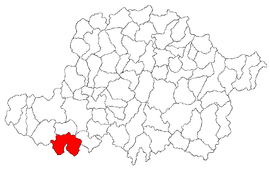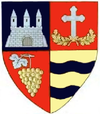Vinga
Vinga | |
|---|---|
 Roman Catholic Church and the square | |
 Location in Arad County | |
| Coordinates: 46°1′N 21°13′E / 46.017°N 21.217°E | |
| Country | Romania |
| County | Arad |
| Area | 155 km2 (60 sq mi) |
| Elevation | 109 m (358 ft) |
| Population (2021-12-01)[1] | 6,083 |
| • Density | 39/km2 (100/sq mi) |
| Time zone | EET/EEST (UTC+2/+3) |
| Vehicle reg. | AR |
Vinga is a commune in Arad County, western Romania, south of the county seat of Arad, with a population of 5,828 inhabitants (as of 2011). Vinga is located in the northern section of the
History
The first evidence of Vinga's existence as a small village dates back to 1231 A.D. After Vinga was destroyed by Turks during the expansion of the
Religion
When Bulgarians came to Vinga, they brought with them their culture, their language, and also their religion of Roman Catholicism. The imposing
Population and ethnic changes
| Changes in population distribution in Vinga village | |||||||||
|---|---|---|---|---|---|---|---|---|---|
| Census[1][2] | Ethnic origin | ||||||||
| Year | Population | Romanians | Banat Bulgarians | Germans | Hungarians
|
Roma
|
Serbs | Slovaks | Other origins |
| 1880 | 4,796 | 263 | 3,543 | 652 | 278 | 6 | 9 | 45 | – |
| 1900 | 4,762 | 455 | 2,818 | 704 | 718 | ? | 31 | 36 | ? |
| 1930 | 4,764 | 1,108 | 2,208 | 392 | 919 | 64 | 14 | 22 | 26 |
| 1977 | 4,617 | 2,239 | 1,103 | 70 | 983 | 181 | 3 | 14 | 20 |
| 1992 | 4,132 | 2,147 | 690 | 40 | 686 | 463 | 5 | 29 | 71 |
| 2002 | 4,218 | 2,632 | 510 | 31 | 533 | 397 | 3 | 18 | 94 |
Demographics
At the 2011 census, the commune had 5828 inhabitants. Of these 58.11% were
. The commune is composed of three villages:| In Romanian | In Hungarian | Ethnic majority |
|---|---|---|
| Mailat | Majláthfalva | Hungarians |
| Mănăștur | Monostor | Romanians |
| Vinga | Vinga | Romanians |
Travel and transportation
There is a major European road running through Vinga (E671), connecting it to Arad to the North and Timișoara to the South. Vinga also has a train station running the same general direction as the road, connecting these two major cities, Arad and Timișoara. Many people in Vinga commute to one of these cities to work. Being a commune, it has two associate small towns (villages) in its administrative jurisdiction: Mănăștur and Mailat.
Natives
Gallery
-
Church
-
Church inside
-
Bulgarian House plaque
-
Mayor's Office, former Franciscan monastery






